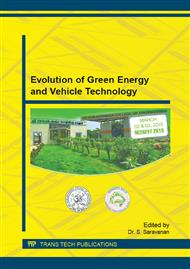[1]
Chithambaramasari, K., Mahalakshmi, N.V., and Jayachandran, K. (2011).
Google Scholar
[2]
Ghosh, S., Chaudhuri, S.N., and Dutta, D. (2013).
Google Scholar
[3]
Koebel, M., Elsener, M., and Kleemann, M. (2000) Urea-Selective Catalytic Reduction System: a promising technique to reduce NOx emissions from automotive diesel engines. Elsevier catalysis today. Pg. 335-345.
DOI: 10.1016/s0920-5861(00)00299-6
Google Scholar
[4]
Himangshu Sekhar Brahma and Veeresh Babu, A. (2013) An experimental investigation on emission of neat Mahua biodiesel using urea-Selective Catalytic Reduction System. International Journal of Scientific & Technology Research. Vol. 2 issue 8.
Google Scholar
[5]
Xiaoyan Shi, Xiaobing Pang and Hu Chen. (2006) Emission reduction potential of using ethanol-biodiesel-diesel fuel blend on a heavy duty diesel engine. Elsevier-Atmospheric Environment 40. Pg: 2567-2574.
DOI: 10.1016/j.atmosenv.2005.12.026
Google Scholar
[6]
Bang Quan He, Shi Jin Shuai and Hong He. (2003) The effect of ethanol blended diesel fuels on emissions from a diesel engine. Elsevier-Atmospheric Environment 37. Pg: 4965-4971.
DOI: 10.1016/j.atmosenv.2003.08.029
Google Scholar
[7]
C. S Cheng, Yage Di and Zuohua Huang. (2008).
Google Scholar
[8]
Tamaldin, N., Roberts, C.A., and Benjamin, S.F. (2010) Experimental study of SCR in a light duty diesel exhaust to provide data for validation of a CFD model using the porous medium approach. SAE International. Pg: 2010-01-1177.
DOI: 10.4271/2010-01-1177
Google Scholar
[9]
Karikalan, L., and Chandrasekaran, M. (2013) Investigation of emission characteristics of CI engine using vegetable oil with SCR technique. International Journal of Renewable Energy Research . Vol. 3 No: 4.
Google Scholar
[10]
Soo Jin Jeong, Sang Jin Lee and Woo Seung Kim. (2007).
Google Scholar
[11]
Solaimuthu, C., Chitra, S., and Rajasekaran, P. (2014) NOx reduction of diesel engine with Madhuca Indica biodiesel using SCR in different flow rates. Journal of Mechanical and Civil Engineering. Vol. 10 No: 5.
DOI: 10.9790/1684-1052834
Google Scholar
[12]
Jothithirumal, B., James Gunasekaran, E., and Saravanan, C.G. (2013) Performance and emission analysis of biodiesel fuelled engine with SCR. International Journal of Engineering and Technology. Vol. 3 No: 2.
Google Scholar
[13]
Ioannis Gekas, Par Gabrielsson and Keld Johansen. (2002).
Google Scholar
[14]
Chun W. Lee and Ravi K. Srivastava. (2004) Investigation of Selective Catalytic Reduction System impact on mercury speciation under simulated NOx emission control conditions. Air & Waste Mangement Association. Pg. 1560-1566.
DOI: 10.1080/10473289.2004.10471009
Google Scholar
[15]
GiuseppeSalvatore Madia. (2002)Measures to enhance the NOxconversion in urea-Selective Catalytic Reduction Systemfor automotive applications. Ph. D Thesis.
Google Scholar
[16]
StefanieTamm. (2010) Studies oftheSelectiveCatalyticReductionofNitrogenOxideswith DimethylEther. Ph. D Thesis.
Google Scholar
[17]
LeiJiang. (2010) Unregulated emissions from a diesel engine equipped with vanadium-based urea-Selective Catalytic Reduction Systemcatalyst. Journal of Environmental Sciences. 22(4)575–581.
DOI: 10.1016/s1001-0742(09)60148-0
Google Scholar
[18]
Juhi Sharaf. (2013) Exhaust emissions and its control technology for an internal combustion engines. International Journal of Engineering Research and Applications. Vol. 3 No: 5.
Google Scholar
[19]
Natarajan, S., Mahalakshmi, N.V., and Sundarraj, S. (2014) Experimental investigation of Homogeneous Charge Compression Ignition of ethanol and diesel blends. Applied Mechanics and Materials. Vol 440, Pg. 254-259.
DOI: 10.4028/www.scientific.net/amm.440.254
Google Scholar
[20]
Sounak Roy, Hegde, M.S., and Giridhar Madras. (2009) Catalysis for NOx abatement – Review. Applied Energy. Pg: 2283-2297.
DOI: 10.1016/j.apenergy.2009.03.022
Google Scholar
[21]
Mary Kay Camarillo, William T Stringfellow, Jereny S Hanbon and Kyle A Watson. (2013) Investigation of Selective Catalytic Reduction for control of nitrogen oxides in full scale dairy energy production. Applied Energy. Vol. 106, Pg: 328-336.
DOI: 10.1016/j.apenergy.2013.01.066
Google Scholar
[22]
Zengying Ziang, Xiaogian ma, Hai Lin and Yuting Tang. (2011) The energy consumption and environmental impacts of SCR technology in china. Applied Energy. Vol. 88 No: 4. Pg. 1120-1129.
DOI: 10.1016/j.apenergy.2010.10.010
Google Scholar
[23]
Rahimpour, M.R., Dehnair, M.R., Jokar, S.M., and Iranshahi, D. (2012) Assessment and comparsion of different catalytic coupling exothermic and endothermic reactions - A review. Applied Energy. Vol. 99. Pg. 496-512.
DOI: 10.1016/j.apenergy.2012.04.003
Google Scholar


